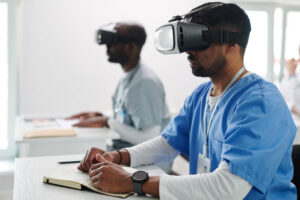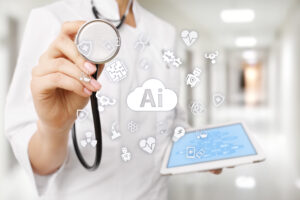5 Trends in Healthcare to Watch in 2022
Covid -19 created a profound impact across the planet. Costing millions of lives, altering social and interactional norms, and disrupting the global economy, the world has needed to quickly adapt to a “new normal.” Of course, there are always silver linings in the darkest of clouds. For the healthcare industry, this silver lining is a reevaluation of its practices and priorities and the emergence of new trends in healthcare.
In large part, there’s a generally-accepted idea of what the future of healthcare should look like. First, future health systems will need to deliver more accessible, scalable, and equitable care while helping to preserve the health of the planet. And secondly, that players should leverage new technology and digital transformation to meet these expectations.
In many ways, industry stakeholders are rising to meet this challenge through technology-driven innovation. As a result, current pivots are reshaping healthcare in multiple ways—how consumers access it, how and which providers deliver it, and what health outcomes it achieves.
Tech providers, health systems, clinicians, payers, and patients expect profound changes to their industry over the next five years. Those on the provider side must not only stay on top of the present transformation but also leverage its advancements to improve operations and stay ahead of the competition.
With the help of the enterprise solutions developers at i3solutions, healthcare institutions can pursue turnkey, tech-driven solutions that accelerate care delivery and improve clinical outcomes. In this blog, our expert consultants explore the most significant trends shaping the future of healthcare today.
#1 – TeleHealth (Telemedicine & Digital Health)
The use of telecommunications technology to deliver care and health services remotely surged during the COVID-19 pandemic. So far, the use of telehealth services has both dipped and grown, but are expected to remain a robust component of healthcare well into the future.
This is due in large part to how well it addresses the industry’s problems with access. For example, a 2020 study found telehealth use during the initial COVID-19 peak (March to April 2020) increased from less than 1%of visits to as much as 80%in places where the pandemic prevalence was high.
According to this McKinsey report, consumer adoption is still up, and 76%of consumers (up from 11% in 2019) report an informed interest in using telehealth. In addition, about 46%have taken that step to replace cancelled healthcare visits. These dynamics are also expected to remain long after the pandemic has been contained.
Fortunately, setting up a telemedicine practice is easier than ever. Licensing requirements are no longer stringent, and the tech side is easily outsourced. With the help of the custom healthcare software developers at i3solutions, you can implement the best synchronous and asynchronous communication standards for your telehealth practice.
#2 – Healthcare Cloud
Driven largely by the economic imperative to cut costs, cloud technology in healthcare is fast becoming a major force. Not only is it facilitating improved quality of care, but it is also revolutionizing the industry as we know it.
An industry with full cloud adoption is desirable, affording benefits including;
- Cheaper, centralized electronic data storage (EMR),
- Real-time Big Data Analytics,
- High-quality communication and collaboration,
- Data security and mobility,
- Advanced automation in Clinical Research, etc.
Apart from the above, deploying health systems in the cloud offers healthcare providers a range of unbeatable benefits – particularly the easy adoption of other cloud-fueled technologies. Cloud computing is almost indispensable for a healthcare future bound for patient-facing solutions – this much is evident from the sheer flood of cloud adoption in healthcare. This is why we think this is a trend to watch in 2022 and beyond. Our portfolio of cloud projects shows a verifiable degree of expertise in delivering cloud solutions. So, you should reach out to our technical solutions experts if you wish to take advantage of this growing trend.
#3 – Extended Reality (XR)
Extended reality (XR) is a blanket term for all the immersive technologies: virtual reality (VR), augmented reality (AR), and mixed reality (MR). No longer a trend for gaming and military uses, XR has been deployed towards potentially transformative applications in the healthcare sector for some time now.
Like most disruptive trends, the potential for extended reality is matched only by its demand. According to this research study, the need for immersive technologies in the Global Healthcare Market is expected to reach USD 40.98 Billion by 2026, up from USD 2.70 Billion in 2020, at a 34.89% compound annual growth rate (CAGR). These statistics point to XR becoming not just a gamechanger for healthcare, but also health education.
For instance, VR headsets are currently used to train doctors and surgeons so efficiently that they could one day eradicate the insatiable need for medical cadavers. VR is also used in therapy for autistic children, cognitive behavioral therapy (CBT), and even schizophrenia – allowing sufferers to work through their fears and psychosis in safe and non-threatening environments.
Applications for XR in healthcare are expected to grow in 2022. For example, AccuVein’s vascular visualization technology, Microsoft’s HoloLens system, and AR tech like the AED4EU Geo Layer are helping, informing, and balancing interactions between patients, clinicians, and healthcare outcomes.
#4 – Robotic Process Automation (RPA)
Robotic Process Automation is fast becoming indispensable to healthcare delivery. So much so that it was essential to the growth the industry seeks to achieve.
For instance, Remote Patient Monitoring (RPM) and Telehealth are advancements that rely primarily on manually processed data. Therefore, any percentage growth in their adoption will always translate to a more significant strain on medical personnel who manually process claims, enter health records, and interact with patients through digital channels.
RPS ensures that those tedious and repetitive tasks are passed on to pre-programmed bots (software) who will execute them in a rule-based way, modeled after how they are done by people. This, in turn, frees up time and staffing for diagnostic work and meaningful doctor-patient transactions.
RPA technology relies primarily on technology that involves several programming frameworks and other multi-layered components where automation workflows are designed and executed. In essence, the technology that i3solutions has mastered to make a difference in your clients’ lives.
#5 – AI/ML and Big Data Analytics
Combating the risks associated with healthcare delivery begins with identifying where it exists and how often it occurs. Artificial Intelligence (AI) and Big data are two instrumental technologies that will drive healthcare outcomes in the future.
AI and Big Data are already transforming healthcare as we know it. Big data involves collecting massive amounts of information (structured and unstructured) created by adopting modern technologies. AI is helping to make sense of the data.
Participate in the digital transformation trends in healthcare
Participating in the current change doesn’t end with just finding out which advancements are used and why. You need to make an effort to utilize the revolutionary tools that will help you provide high-quality care.
Contact us at i3solutions to learn how we can help you harness the power of technology to create more connected, resilient and effective healthcare solutions for you and your customers. We have considerable experience helping hospitals, institutions, and other healthcare organizations make the most of their people, processes, and technology. Reach out to us to learn more today.
Leave a Comment






